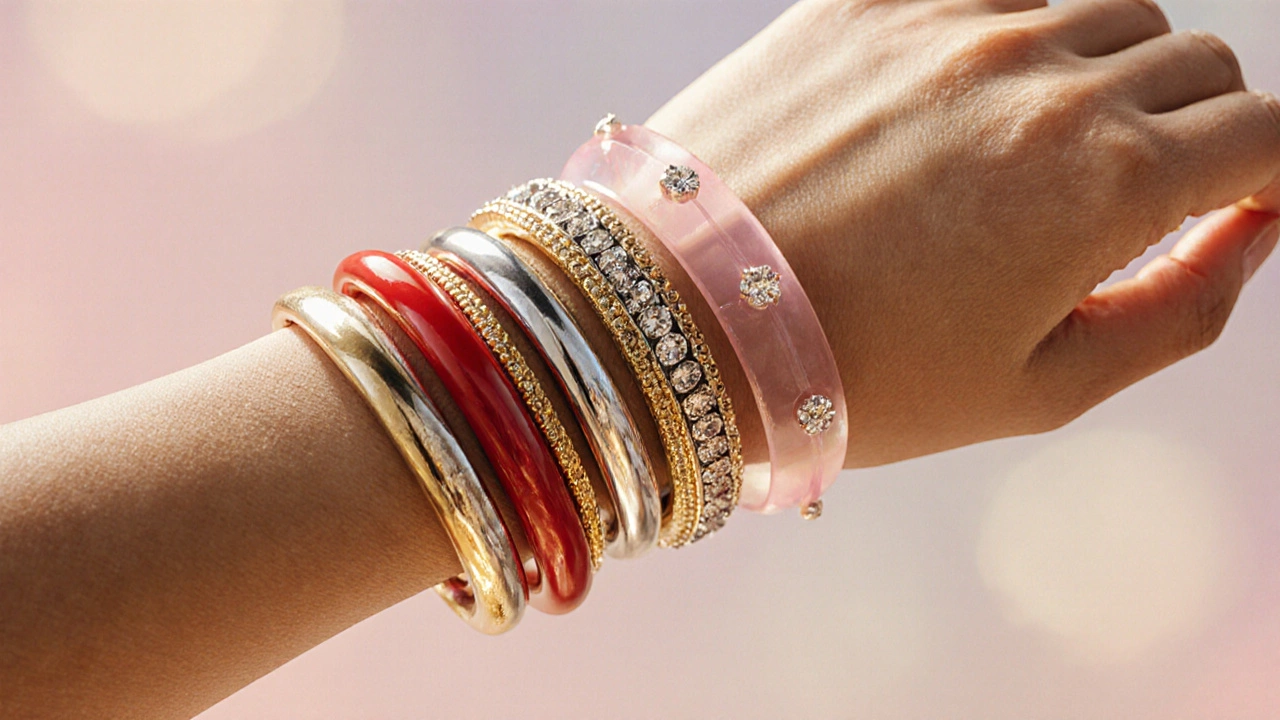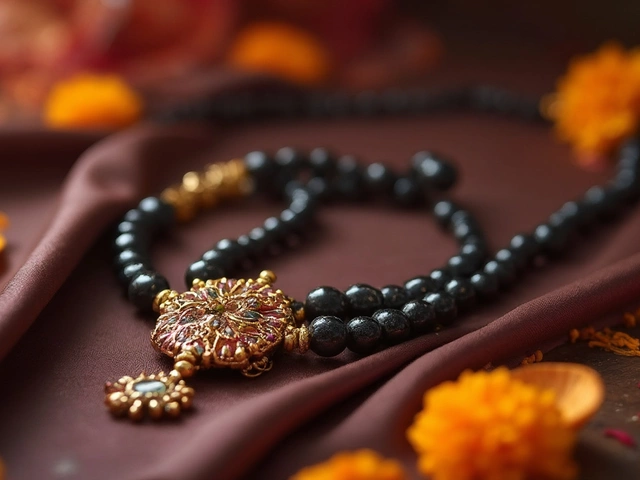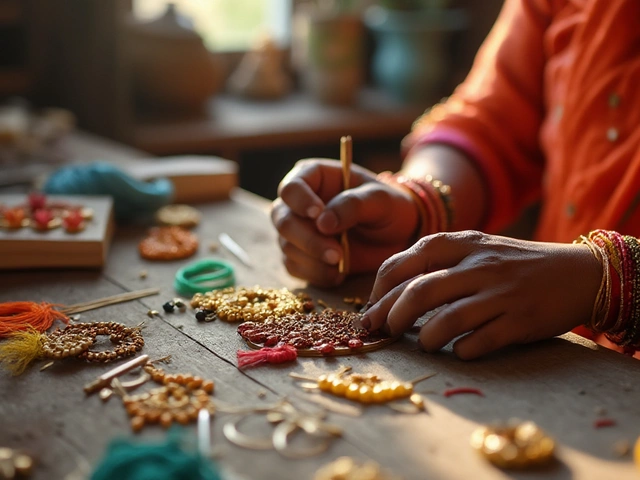When it comes to Indian wrist adornments, Bangles are solid, usually unhinged bracelets made from metal, glass, plastic or stone, worn in multiples. Chooda refers to a set of long, often red and ivory ivory or glass bangles traditionally gifted to brides in Punjabi and Rajasthani weddings. Both pieces are iconic, but they serve different cultural roles, look distinct, and follow unique buying rules. Below you’ll find everything you need to tell them apart, pick the right set for a ceremony, and keep them shining for years.
Quick Takeaways
- Bangles are everyday or festive wristwear, typically made of metal, glass, or plastic and come in many colors.
- Chooda is a bridal gift set, usually red and ivory, made of ivory, glass, or polki (unpolished diamonds) and tied to Punjabi/Rajasthani rituals.
- Structure: bangles are single‑piece bracelets; chooda consists of a series of 11‑13 tightly linked pieces.
- Materials: bangles use gold, silver, lac, or acrylic; chooda relies on ivory (or eco‑friendly alternatives), red glass, and sometimes Polki embellishments.
- Care: bangles often need polishing; chooda requires gentle cleaning to avoid dulling the ivory.
What Are Bangles?
Bangles trace back to the Indus Valley Civilization, where archaeologists found clay beads resembling modern wrist bands. Over centuries they evolved into solid circles that slide over the hand. Today you’ll meet several popular types:
- Gold bangles - classic, heavy, often worn by brides and during festivals.
- Silver bangles - lighter, suitable for daily wear and spiritual occasions.
- Lac bangles - lacquered wood or metal coated with bright colors, typical for weddings in Gujarat and Rajasthan.
- Glass bangles - transparent or colored, popular at weddings across North India.
- Polki bangles - set with uncut diamond pieces, a hallmark of luxury bridal looks.
While the material varies, the silhouette stays the same: a rigid cylinder no larger than a few centimeters in width. Women often stack 5‑12 bangles on each arm, creating a rhythmic clink that signals celebration. The number of bangles can have symbolic meanings - for example, seven gold bangles ("Sat Sringar") represent the seven vows of a Hindu marriage.
What Is Chooda?
Chooda is rooted in Punjabi and Rajasthani bridal customs. The name comes from the Hindi word “chood” meaning “to adorn.” A typical chooda set includes 11‑13 bracelets, starting with an ivory (or imitation ivory) piece, followed by a series of red glass bangles, and ending with a larger ivory cuff. The colors are not random: red symbolizes fertility and marital bliss, while ivory stands for purity and longevity.
The tradition began as a gift from the bride’s maternal family, meant to protect her and bless the new household. In modern times, chooda has moved beyond Punjab; brides in Delhi, Mumbai, and even overseas Indian communities often include a chooda ceremony before the main wedding rituals.
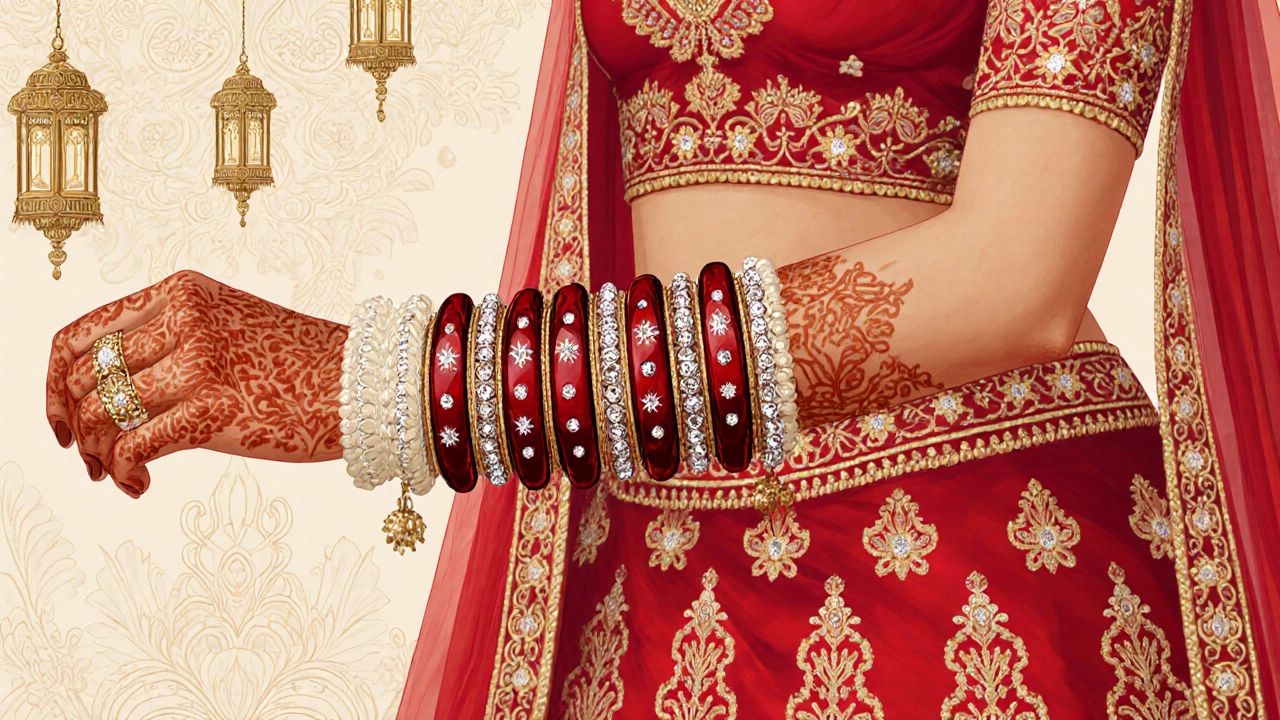
Side‑by‑Side Comparison
| Aspect | Bangles | Chooda |
|---|---|---|
| Primary purpose | Everyday or festive wristwear | Bridal gift set, specific to wedding rituals |
| Typical material | Gold, silver, lac, glass, acrylic, Polki | Ivory (or eco‑friendly alternative), red glass, occasional Polki |
| Number of pieces | 5‑12 per arm, can vary | 11‑13 linked pieces, uniform across both arms |
| Regional association | Pan‑India, especially Gujarat, Rajasthan, South India | Punjab, Rajasthan, and diaspora weddings |
| Color palette | Wide spectrum - gold, silver, pink, blue, multicolored | Predominantly red and ivory; occasional gold accents |
| Symbolism | Prosperity, health, marital status (number of bangles) | Fertility (red) and purity (ivory); signifies bride’s new role |
| Typical price range (2025) | ₹2,000 - ₹150,000 depending on metal and craftsmanship | ₹8,000 - ₹120,000 for authentic ivory / eco‑ivory sets |
Choosing the Right Set for Your Event
If you’re attending a wedding as a guest, bangles are the safe bet. Pick a color that matches your outfit and consider the venue’s vibe - glass or lac for a traditional ceremony, acrylic for a modern reception. For a bride, the decision hinges on the community’s customs. In a Punjabi wedding, a chooda ceremony usually occurs a day before the main functions; you’ll pair the chooda with a white or pastel wedding dress, then swap to a gold‑laden bridal set after the Saptapadi (seven steps) ritual.
Some families blend traditions: a bride might wear a handful of gold bangles alongside the chooda for a mixed‑heritage look. In such cases, ensure the bangles are lightweight so they don’t clash with the heavier ivory pieces.
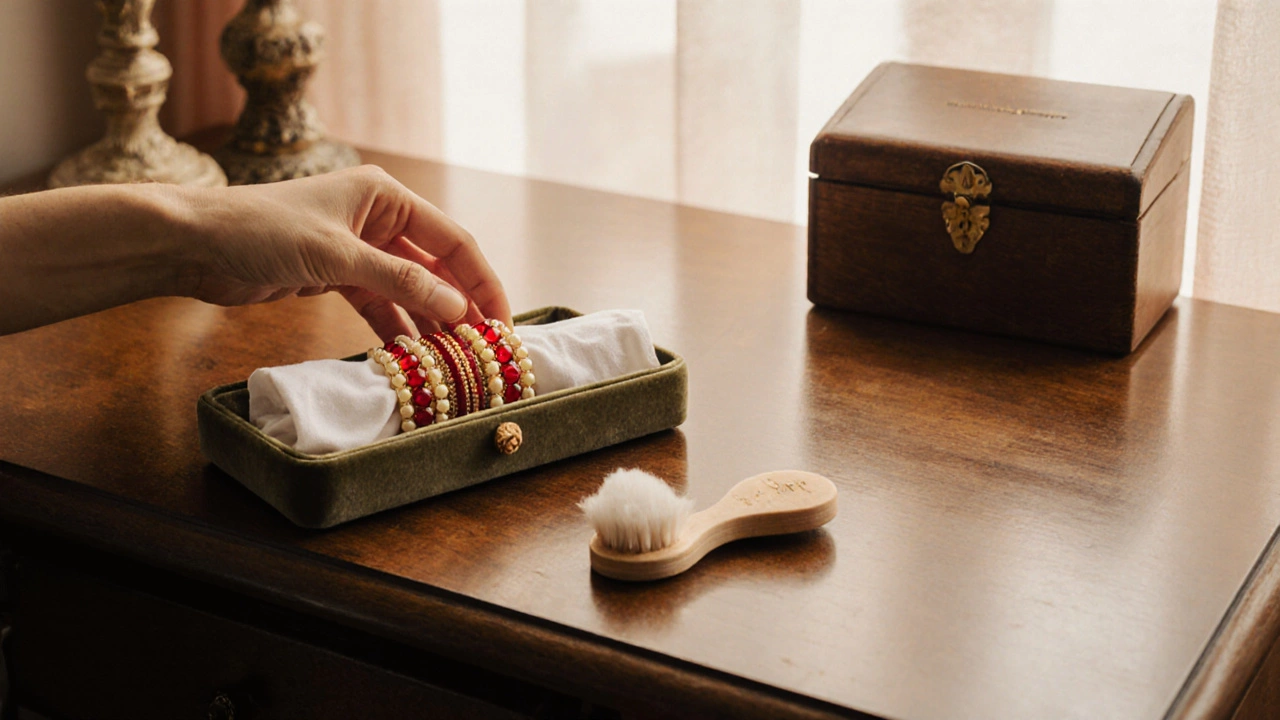
Care & Maintenance
Both bangles and chooda need gentle handling to retain their shine:
- Gold and silver bangles: wipe with a soft cloth after each use; store in a lined box away from humidity.
- Glass and lac bangles: avoid sudden temperature changes; clean with lukewarm water and a mild detergent.
- Ivory (or eco‑ivory) chooda: dust with a dry brush; do not submerge in water; occasional polishing with a walnut‑oil dab keeps the surface supple.
- Polki embellishments: keep away from harsh chemicals; a soft cotton swab can remove fingerprints without scratching the stone.
When traveling, wrap each piece individually in cotton cloths and place them in a hard‑shell jewelry case. This prevents clinking, which can cause minor dents over long journeys.
Where to Find Authentic Pieces
India boasts several trusted markets for genuine bangles and chooda:
- Johari Bazaar, Jaipur: known for gold and silver bangles with intricate Kundan work.
- Zaveri Bazaar, Mumbai: offers a wide range of glass and lac bangles at varying price points.
- Chandni Chowk, Delhi: home to traditional ivory‑style chooda sets, many of which now use ethically sourced bone or resin.
- Online platforms: sites like CaratLane and Ethnic Basket provide certified authenticity cards, especially for Polki and Kundan pieces.
Always ask for a purity certificate (for gold) or a material safety sheet (for ivory alternatives). Reputable sellers will gladly provide these documents.
Frequently Asked Questions
Can I wear chooda after the wedding?
Traditionally, chooda is kept on for the first month of marriage as a protective charm. Some brides continue wearing it for special occasions, but many store it safely after the initial month.
Are there vegan alternatives to ivory chooda?
Yes. Modern designers use bone, resin, or polymer‑based "eco‑ivory" that mimics the look and weight of real ivory without harming animals.
What does the number of bangles signify?
Numbers vary by region: seven gold bangles (Sat Sringar) for marital vows, nine for prosperity, twelve for completeness in some South Indian rituals.
Is it okay to mix metal bangles with chooda?
Mixing is common in mixed‑heritage weddings. Choose lightweight metal bangles (silver or thin gold) to avoid extra weight on the ivory pieces.
How often should I clean my bangles?
After every major event, wipe them with a soft cloth. For gold and silver, a quarterly polishing with a jeweler’s solution keeps them lustrous.
Whether you’re a bride planning her first‑day shine or a lover of Indian heritage looking to add a splash of color, understanding the nuances between bangles and chooda lets you make an informed choice. The right set not only complements your outfit but also honors centuries‑old traditions that continue to sparkle in modern India.
